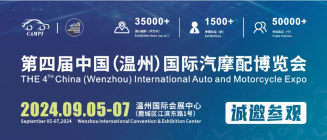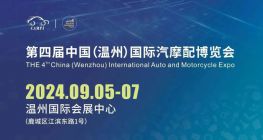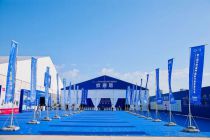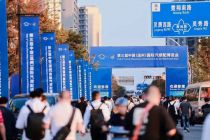From December 23 to 24, the 2022 China Automobile Supply Chain Summit and the 7th Lingxuan Award Ceremony were held in Wuhan.
At the meeting, Wang Ruiping, Senior Vice President of Geely Automobile Group and President of Power Research Institute, delivered a keynote speech. The following is the transcript of the guest speech:

Good morning, everyone! At the end of this year, we will sum up the past year. Despite the impact of the epidemic, the international situation, the lack of core and power, and the supply side, the overall development of the automotive industry continues the general trend of electrification transformation in 2021, and the growth rate is greatly accelerated. Today, I would like to share with you our views on the new pattern of automobile electrification and our thinking in the transformation of the supply chain on the platform of the Supply Chain Conference.
First of all, I'd like to take a look at Geely's brand family. It covers from hybrid to electric, from passenger cars to commercial vehicles, and from popular brands to high-end products. It is a very comprehensive group brand family.
Geely Power's product line includes 1.5 and 2.0 engines, a DCT transmission with a torque of 300 to 380 Nm, and a special electromechanical coupling 3DHT transmission for hybrid. We also have pure electric drive and hybrid electric drive, as well as related parts and components, which are also open to the whole industry. It can be said that we represent not only the OEMs, but also a link in the supply chain.
Next, let's take a look at the market trend. First, look at the changes in the international market. Although the total sales volume of the automobile market has declined after the epidemic, the sales volume of new energy has increased rapidly. It is worth noting that the electrification rate of the European market in the first three quarters has reached 30%, which includes HEV, PHEV and EV. However, the process of electrification in the United States is relatively slow, reaching 13%, which is 18% lower than the global average.
Looking at the Chinese market, although the overall growth rate is not large, the structure has changed a lot. The data from January to October showed that fuel vehicles dropped by 20%, HEV increased by 36%, PHEV increased by 143%, and EV increased by 74%. PHEV has the highest growth rate, and the overall electrification rate, like Europe, reached 30%. This also shows that the market pattern dominated by electrification in the automobile market is taking shape.
Where does the driving force of market change come from? We think it is driven by G, B and C, that is, the policy side, the industry side and the client side.
Let's take a look at the policy driven results. In general, after 11 years of policy incentives, the new energy market has grown to the scale of more than 5 million output this year, and the market is still very broad. Under the influence of the policy, the market will go through four stages, from the cultivation period started in 2009 to the increase of subsidies in 2014, entering the promotion period. From 2019 to now, the subsidies have declined significantly, which is in the transition period. The subsidies will be cancelled from 2023, but the purchase tax preference will continue to the end of 2023. After 2024, it is expected that all policies will be withdrawn, and new energy development will enter into marketization, fully relying on technical level and product strength to compete in marketization.
At the same time, from the perspective of resources, with the rapid growth of new energy, the demand will become larger and larger, so the growth process is also faced with the risk of raw material supply. For example, the key raw materials for batteries, lithium, cobalt and nickel, although their total reserves can meet the current demand, these resources are mainly distributed in South America, Australia and other countries. For China, these resources are mainly imported. Therefore, with the development of new energy, the domestic automobile enterprises are facing the pressure of resource cost and the risk of trade will also increase, that is to say, the single development of pure electric vehicles is also facing the risk of insufficient resource supply, which will also lead to higher costs. Therefore, from the perspective of resources, there should also be a variety of different technical routes to achieve balanced development.
From the enterprise side, in order to adapt to the trend of electrification, each enterprise also adopts different technical routes to meet the requirements of the policy and market according to its own characteristics. At present, several mainstream technical routes are HEV, PHEV, REEV and BEV. PHEV and REEV are technical routes that are easy to confuse, and there are also many controversies about which is the better energy-saving route.
The difference between them is that PHEV can switch freely between series and parallel through intelligent control, and can achieve the best results in both power and fuel consumption. While REEV is relatively easy to realize from the technical point of view, due to its single mode, which only uses series connection and cannot drive the engine directly, it will sacrifice some efficiency on high-speed. Of course, customers who like the incremental driving experience similar to electric vehicles and are not sensitive to fuel consumption are also willing to accept it.
Technically, HEV and PHEV in the hybrid power system have the highest technical threshold, because their control modes are the most complex, but their power performance and economy are also the best.
Therefore, the above four different technical routes have their suitable customer groups.
When coming to the C end, the demand for customers is also diversified. For different use cases, BEV is the first one. It is suitable for customers who just need new energy with charging conditions. However, considering the anxiety of mileage, generally speaking, families with two cars will consider electric vehicles. For PHEV and REEV, it is suitable for new energy customers with long-distance travel needs. It can not only experience the driving of electric vehicles, but also relieve mileage anxiety. HEV is suitable for the most popular fuel car customers. It does not need to be charged, and the fuel saving effect is also very obvious. Especially at the current stage of high oil prices, taking Geely Raytheon (parameter | picture) hybrid technology as an example, the fuel saving can reach more than 40%, which is equivalent to the return of the oil price to the era of 5 yuan. It can also enjoy the blessing of new energy elements such as intelligent networking.
Based on the analysis of market driving force, the electrification of the future automobile market should be said to be a foregone conclusion, and its pattern will show the following characteristics.
HEV and PHEV have wider adaptability due to their convenience in use and remarkable energy-saving effect for customers, and will occupy a larger intermediate body in the future. BEV is restricted by charging conditions and will occupy both ends of the market. On the one hand, it is aimed at customers who are pursuing high-performance electric vehicle driving experience, and on the other hand, it is aimed at those customers who need short distance small cars.
Therefore, for the prediction of the future, on the premise that the subsidy is declining and the policy is neutral, we think that BEV, PHEV and HEV have their own needs and will share the world.
Now I would like to talk about the impact of the transformation of the automotive industry on the supply chain in the light of the current market environment. The reason why automobile is called a pillar industry is that the industry chain of automobile is very long. It can drive the upstream and downstream to develop together, which also links the fate of raw materials, parts supply and main engine manufacturers. Therefore, the change of the market development direction has a great impact on the supply chain.
Specifically, the supply chain is also rapidly transforming and upgrading with the development of new energy. It is worth noting that new energy has driven the development of automobile electrification and intelligence, which has also led to a sharp rise in the proportion of the cost of electronic products, especially hybrid electric vehicles and pure electric vehicles. The proportion of electrified products has reached 47% to 65%. In fact, it also brings business opportunities for parts enterprises, and also spawns a large number of new technology enterprises to join the auto parts industry. At the same time, some traditional parts enterprises are also transforming to electric polarization, hoping to continue to lead in the new energy era. Therefore, the electrification of automobiles has also contributed to the new pattern of the supply chain.
In the new pattern, emerging suppliers and traditional suppliers have their own strengths. The advantages of emerging suppliers are reflected in their fast response to the market and lack of historical ambitions; In addition, the management is relatively flexible and efficient. For the advantages of traditional suppliers, it has a perfect auto parts development system and a mature cooperative relationship with the OEMs. It has a long-term technological precipitation and excellent talent accumulation. So it has very strong strength.
In the face of emerging suppliers, we certainly maintain an open attitude of cooperation and are willing to use our perfect management system to support the growth of suppliers. In the face of traditional suppliers, we are also willing to work together for transformation. At the same time, we also believe that these suppliers have excellent talents and strong learning ability, so they can also use their deep technical deposits to quickly master new knowledge and make rapid breakthroughs in emerging areas.
The adjustment of the market pattern has formed a tripartite linkage relationship with the OEMs and the supply chain. From the market side, the policy, technology and demand are constantly changing. The change of the market requires the OEMs to respond in time and provide the required terminal products. The supply chain will adjust with the OEMs to meet the market demand. However, due to the long supply chain, the transformation process also requires a long cycle. To form efficient and fast response from upstream to the end, the supply chain and the OEMs need to form closer cooperation.
How should vehicle manufacturers and parts cooperate to achieve a win-win situation? First, let's take a look at the main pain points we face.
The first is the expected difficulty of the market. The actual demand and expectation change greatly, which leads to redundant input in the supply chain or demand exceeding supply. I believe many enterprises will encounter such problems.
The second is to accelerate product iteration and shorten the development cycle. There is an urgent need for OEMs to launch new products, and suppliers need to speed up the pace to keep up with OEMs.
Third, the cost pressure is increasing, especially the supply of rare materials in the market is tight, and the price of raw materials is soaring. For example, the rise of battery materials has led to a sharp rise in the cost of the whole vehicle.
How can we achieve win-win results? First of all, we think it is important to share the strategic direction. We should establish a strategic communication mechanism between the two sides to create a redundancy period for transformation and iteration, and achieve win-win and sustainable development in a reasonable competitive environment.
The second is joint project management. Just like the way we and our Schaeffler work with other suppliers, we need to establish a joint management mechanism to jointly manage possible risks. Only in this way can we cooperate deeply and achieve systematic and efficient collaboration in the event of a crisis.
The third is a reasonable premium system. In terms of cost control, we should also establish a reasonable premium system, maintain a long-term trust relationship on the basis of mutual trust, constantly strive to reduce costs, and constantly improve the cost performance ratio of products, so as to maintain the market competitiveness of our end products and form sustainable development. This is the way to achieve a win-win situation for the whole.
For example, the automotive supply chain in 2022 will also face many specific problems, such as lack of core and power and the impact of epidemic. Compared with 2021, the supply guarantee problem is still prominent. Its difficulty lies in that first, it needs to solve the shortage of materials in the industry, and in addition, it needs to increase production in the short term to adapt to changes in the market.
Taking the process of production and supply assurance of the three DHT Pro, the core product of Geely Raytheon Hybrid, as an example, we worked closely with Sheffler, an important supplier. After 220 days of close cooperation, we held a global high-level joint daily clearing meeting with the German headquarters, made collaborative procurement of 4600 equipment and materials, and finally reached a production increase plan. This is a very successful case of integration and win-win cooperation.
Some global parts suppliers, such as Hitachi and Borg Warner, have also made great contributions to our warranty process. This fully shows that the zero point relationship can achieve win-win through close collaboration.
Why is it important to guarantee supply? Because this three gear transmission is the key technology of the Thunderobot hybrid platform born by Geely in the transformation of new energy.
What is Raytheon's hybrid technology? Take this opportunity to make a brief introduction. Raytheon Hybrid is a hybrid platform architecture, which has a wide bandwidth, can cover different levels of models from A0 to D, and supports different hybrid technology routes of HEV, PHEV and REEV. Raytheon hybrid platform type spectrum includes 1.5 and 2.0 DHE hybrid special engines, DHT Pro three gear hybrid transmission, plus electric rear axle EDU, battery and its software architecture. Among them, the three gear DHT Pro gearbox is the core of Raytheon hybrid system, which also integrates the world's top resources and ensures the design quality and high-end attributes of the product through cooperation with top suppliers.
Raytheon technology combines the advantages of two hybrid systems, namely, strong European power and low Japanese fuel consumption. It has achieved a disruptive technological breakthrough in an all-round way and created a new pattern of original large-scale technologies in the core areas of China's own brands. In the past, many people believed that our powertrain technology was completely followed, which was not leading enough. The birth of Geely's third gear DHT Pro can be said to break the international technical barriers, achieve the goal from benchmarking to benchmarking, and also provide an efficient solution to meet the "dual carbon" standard.
This system is a complete set of layout, reaching the industry's most compact axial length of 354mm. In addition, its lightweight design can output 4920Nm of ultra-high wheel side torque, which is far higher than the industry level.
The intelligent control software of Raytheon hybrid system is also self-developed by the whole stack, and has passed the certification of ASIL D of functional safety in Europe and ASPICE L3 developed by the electronic control software. This should also be the first enterprise with its own brand to obtain both certifications at the system level in the hybrid system field.
It is worth mentioning that the Geely Star Yue L Hi-P equipped with Raytheon technology has three modes for you to choose: pure electric, extended range and hybrid. Its longest range can reach 1300 kilometers, which means that you can have three different experiences when buying a car.
Next, let's make a summary. For the pattern of electrification, we believe that hybrid electric is not an excessive technology. Hybrid electric will coexist for a long time and compete with each other. In the future, under the premise of policy neutrality, HEV, PHEV and BEV will share the market.
Second, in terms of the integration relationship, OEMs and the supply chain should strengthen in-depth cooperation to jointly respond to complex market changes.
Finally, with its advanced technology and competitive products, Geely's Raytheon hybrid system will play an important role in the electrification process of China's automobile market in the future.
For the future powertrain, we believe that it will develop towards the direction of high efficiency of power, electrification of drive, intelligence of control and "new four modernizations" of power with diversified energy sources.
Finally, Jilin Leishen Power is also willing to join hands with the supply chain to achieve win-win results in the transformation and development of power. Thank you!
On September 5th, we invite you to join us at the Wenzhou Auto Parts Exhibition on a journey to trace the origin of the Auto Parts City, as per the invitation from the purchaser!
Hot Booking | AAPEX 2024- Professional Exhibition Channel for Entering the North American Auto Parts Market
The wind is just right, Qianchuan Hui! Looking forward to working with you at the 2024 Wenzhou Auto Parts Exhibition and composing a new chapter!
Live up to Shaohua | Wenzhou Auto Parts Exhibition, these wonderful moments are worth remembering!
Bridgestone exits Russia and sells assets to S8 Capital
Live Up to Expectations and Honor to End | 2023 Wenzhou International Auto Parts Exhibition Successfully Ends! Looking forward to meeting you in 2024!
Free support line!
Email Support!
Working Days/Hours!





